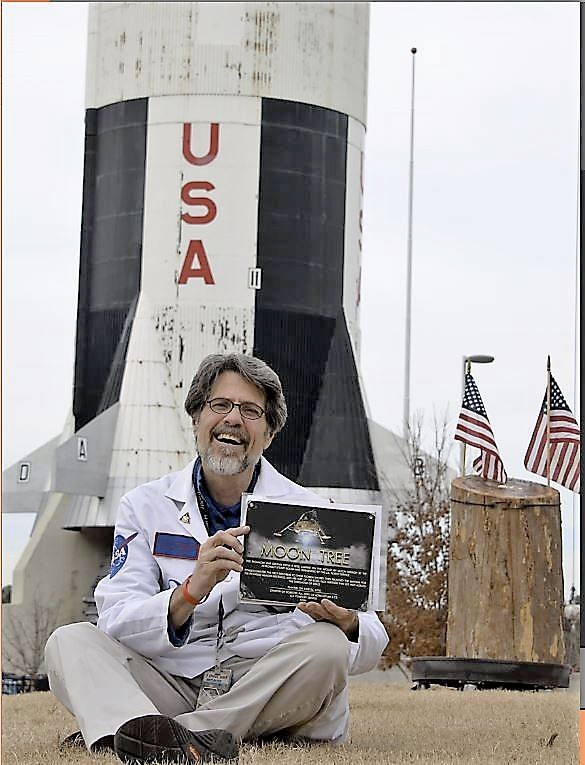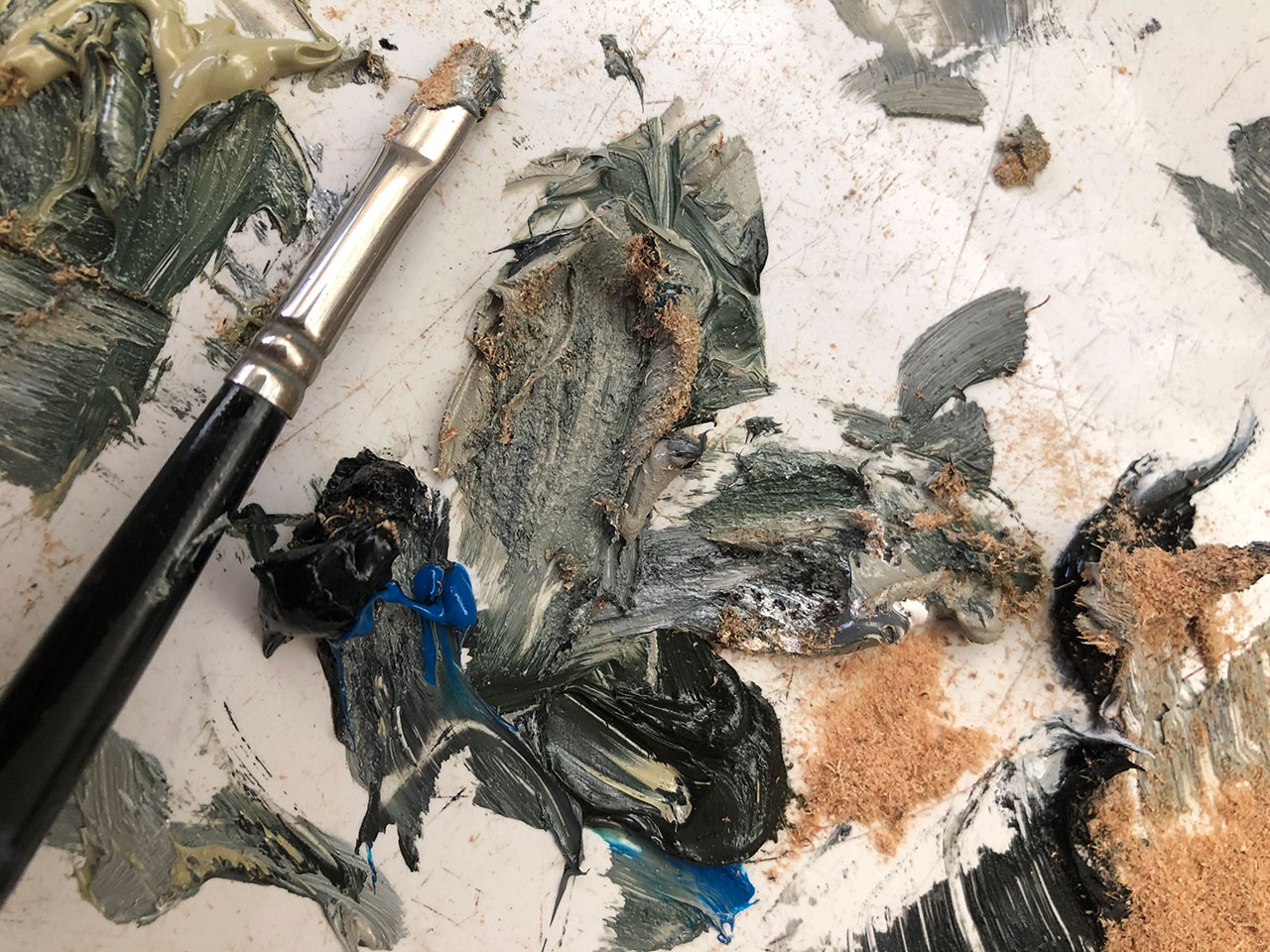Artist adds touch of moon (tree) dust for Apollo 14 50th anniversary

A new tribute to the 50th anniversary of NASA's Apollo 14 lunar landing mission has grown out of a collaboration between two artists and a touch of moon dust, of sorts.
"Touched by the Moon," a new oil painting by artist Chris Calle, captures the view that astronauts Alan Shepard, Ed Mitchell and Stu Roosa had from lunar orbit 50 years ago this week. More than what they saw, though, embedded in the painting are remnants of a once-living monument to the Apollo 14 lunar landing.
"I hadn't planned on working on anything with this sawdust, because I didn't know about it," Calle said in an interview with collectSPACE.com. "That is, until Scott Phillips approached me."
Related: Apollo 14 moon landing and golf shot in photos
History of NASA: $22.99 at Magazines Direct
Discover the story of how and why NASA was created, its greatest triumphs, darkest days, and of the times it exceeded all possible hopes. A tale of adventure, heroism and resourcefulness, learn of the space agency's greatest achievements and how — over six decades — the organization has consistently and tirelessly devoted itself to its founding principle: that "activities in space should be devoted to peaceful purposes for the benefit of all humankind".
Log and legacies
A former space shuttle technician, Phillips today sculpts distinctive models of the winged spacecraft from rare woods. In 2017, he was entrusted with a segment of a Sycamore tree that fell in a hurricane. Originally planted at NASA's Kennedy Space Center Visitor Complex in 1976, the tree had grown from a seed that was carried aboard Apollo 14 to the moon. (Roosa flew 500 seeds from five species of trees as a nod to his past as a smoke jumper for the U.S. Forest Service.)
Phillips used the Sycamore wood to create sculptures for a new "Moon Tree" garden that was planted at the Kennedy Space Center for the 50th anniversary of the Apollo program in 2019. Left behind was a pile of moon tree sawdust.
"In talking with Chris, he was inspired by the late Alan Bean (Apollo 12 artist) to continue his legacy to include something from the moon in his artwork," Phillips said. "Chris has taken on the mantle as the only artist in our space community to use his exquisite talent to paint a master painting, incorporating the sawdust."
Breaking space news, the latest updates on rocket launches, skywatching events and more!
Moon Mission's Living Monuments: Apollo 14's 'Moon Trees' live on
In creating "Touched by the Moon," Calle was, in fact, carrying on two legacies.
"It's my homage to Alan Bean, adding something that flew, something related to the mission, to the piece," said Calle. "He always appreciated asking my dad advice about art and I always appreciated asking Alan about the things he did in his art. So that's a nice continuity."
Calle's father, Paul, was one of the first eight artists chosen by NASA to document its activities and was the only artist present when the Apollo 11 astronauts suited up for their launch. Paul Calle, who died in 2010, created the art for the "First Man on the Moon" 1969 postage stamp, and together, Paul and Chris designed stamps for the 25th anniversary of the first moon landing.
Related: NASA's 17 Apollo Moon Missions in Pictures
Dust-driven
With the Apollo 14 moon tree sawdust in hand, Calle said that Earthrise became the natural choice for the 50th anniversary painting.
"When I began to think about what image would best represent the ideas of the seeds flying to the moon and then returning here to Earth, being planted and spread throughout the world, it became really clear to me what to paint," Calle told collectSPACE. "Specifically, I started thinking about Earthrise, the Earth rising from behind the moon, as so many astronauts had seen it on Apollo."
The view of Earthrise, first seen by the crew of Apollo 8, is largely credited with giving rise to the environmental movement, having changed the way we viewed our planet.
"There is a great quote from Apollo 8 astronaut Bill Anders who said, 'We came all this way to explore the moon and the most important thing is that we discovered the Earth,'" said Calle.
Dabs and dimples
Adding the moon tree sawdust helped shape the way Calle painted the scene.
"I applied the paint very thick because with the sawdust mixed in it had to stick in the paint. It wouldn't have really worked if I had applied thin layers, because then you would have seen too much of that rough sawdust. I practiced with it and it just didn't look like I wanted it to look, so I really applied thick, thick paint," said Calle.
Most of the moon tree dust is concentrated in the paint for the lunar surface and in the black sky. Calle, though, has plans to enhance the depiction of Earth, too, and for a good cause.
At Phillips' suggestion, a limited number of giclee canvas prints are planned for sale to benefit the Moon Tree Foundation, a non-profit organization founded by Roosa's daughter, Rosemary, to promote educating the world about the history of space exploration and the legacy of the moon trees.
"I will hand enhance Earth, basically painting Earth again," said Calle. "I will use more moon tree dust in those enhancements, so the original painting will have the sawdust used in the lunar surface, because that's where the seeds went, and then in the enhanced prints, it will be used to enhance Earth, representing where the seeds came back, getting back to Earth."
Calle also plans to add one more subtle nod to the Apollo 14 mission. Before leaving the moon on Feb. 6, 1971, Shepard famously used a makeshift golf club to hit a couple of golf balls off the moon.
"I am going to take a golf ball, dip it in paint and put a little impression, just a little dimple," he said. "I know exactly where I will put it."
Follow collectSPACE.com on Facebook and on Twitter at @collectSPACE. Copyright 2021 collectSPACE.com. All rights reserved.

Robert Pearlman is a space historian, journalist and the founder and editor of collectSPACE.com, a daily news publication and community devoted to space history with a particular focus on how and where space exploration intersects with pop culture. Pearlman is also a contributing writer for Space.com and co-author of "Space Stations: The Art, Science, and Reality of Working in Space” published by Smithsonian Books in 2018.
In 2009, he was inducted into the U.S. Space Camp Hall of Fame in Huntsville, Alabama. In 2021, he was honored by the American Astronautical Society with the Ordway Award for Sustained Excellence in Spaceflight History. In 2023, the National Space Club Florida Committee recognized Pearlman with the Kolcum News and Communications Award for excellence in telling the space story along the Space Coast and throughout the world.





